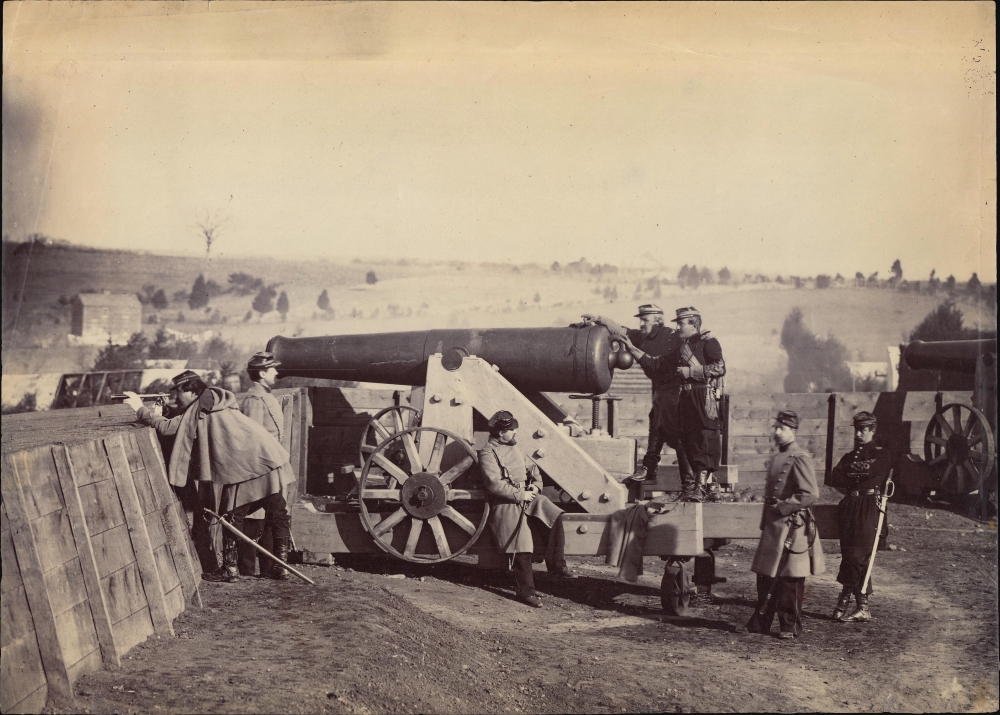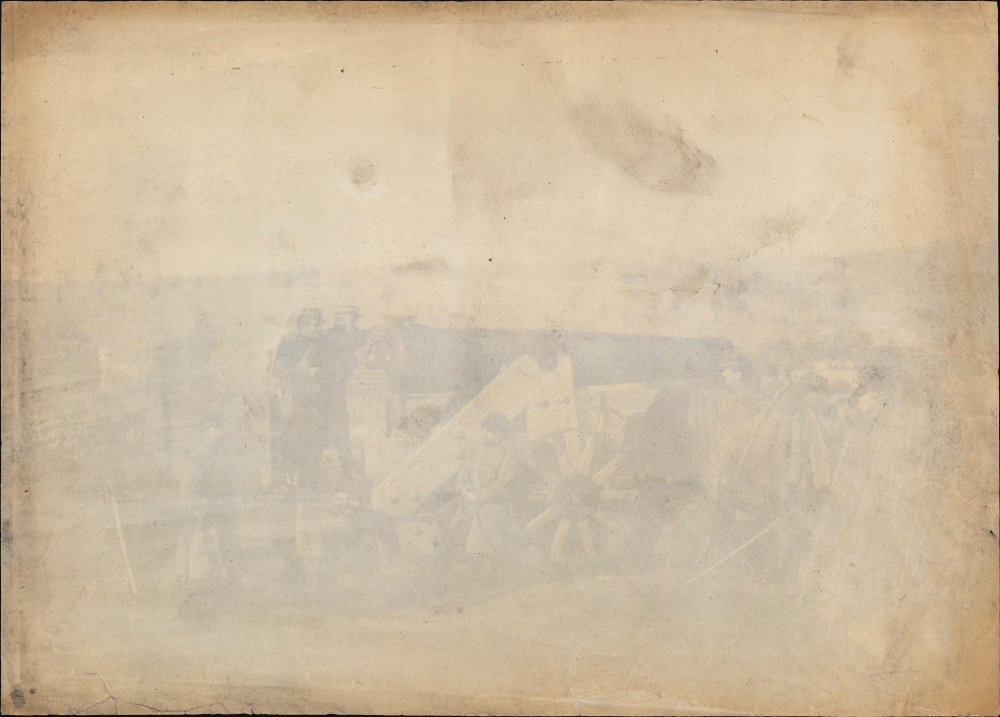This item has been sold, but you can get on the Waitlist to be notified if another example becomes available.
1861 Brady Civil War Albumen Photograph at Fort Gaines near Tenleytown
55thNYFortGainesArtillery-brady-1863
Title
1863 (undated) 10 x 13.875 in (25.4 x 35.2425 cm)
Description
A Closer Look
A large artillery piece mounted on a carriage is the focal point, with seven Union soldiers manning the gun. One looks through a spyglass towards the left, while the other six lounge nonchalantly. A second artillery piece appears along the right border. Trees and a farm house are visible in the background.Fort Gaines
Fort Gaines was established in 1861 in northwest Washington D.C. as one of a series of forts created to protect and defend the capital during the U.S. Civil War. An earthwork fort, it was named for Brigadier General Edmund Pendleton Gaines, a U.S. Army veteran of the War of 1812, the Seminole War, and the Mexican War. Later in the war, Fort Gaines was relegated to reserve status after the expansion of Fort Reno and the construction of Fort Bayard. The fort was abandoned in 1865 and no longer exists, but was situated near Ward Circle on the grounds of American University.The 55th New York Infantry Regiment
The 55th New York Infantry Regiment was mustered in to service on August 28, 1861, near New Dorp, Staten Island, New York. The regiment left for Washington, D.C. on August 31, 1861, and was on duty at Fort Gaines during September and October 1861. They continued to man the defenses of Washington, D.C. until March 1862, when they were part of the Peninsular Campaign. The 55th New York fought at the Siege of Yorktown, the Battle of Williamsburg, the Battle of Seven Pines, the Seven Days Battles, and the Battle of Malvern Hill. They then returned to Washington in August and manned the city's defenses until October. Their final action was fighting in the Battle of Fredericksburg, December 12 - 15, 1862. The regiment ceased to exist when it was consolidated into the 38th New York Infantry Regiment on December 21, 1862, as Companies G, H, I, and K.Mathew Brady and Civil War Photography
Mathew Brady (c. 1822-1824 - January 15, 1896) was a successful portraitist and photographer at the beginning of the American Civil War (1861 - 1865). At the outbreak of the war, he advertised his services to take portraits of soldiers leaving to fight, making popular cartes de visites. Soon, he realized that the new technology could be used to document the war.Brady's effort, into which he invested at least $100,000 of his own money, has dubbed him the 'first photojournalist'. He developed mobile dark rooms and other photographic equipment to make this undertaking possible. Brady hired a cadre over 20 photographers, developers, and other workers to assist in this task. Many of Brady's photographers, including Alexander Gardner, Timothy O'Sullivan, George Barnard, Egbert Guy Fowx, and Thomas C. Roche, took iconic photographs that resonate to this day. However, Brady took and copyrighted most of the images under his own name as 'Brady and Company'. This caused ruptures with some photographers (most notably the extremely talented Gardner), which had repercussions for the rest of his life. The 'myth' of Brady's photographic prowess overshadowed any successes by other photographers, whether they worked for him or not. To this day most Civil War photography is attributed to Brady. Some have suggested, due to his failing eyesight, that he acted more as a director, making few of the field photographs himself. Historians generally see Brady's role as organizer, financier, advertiser, and entrepreneur. His insistence on using the 'Brady and Company' imprint on all images without giving credit to the individual photographers has complicated his legacy and made identifying specific photographers under the company umbrella challenging - if not impossible.
Publication History and Census
This 1861 photograph is attributed to both Mathew Brady and Brady and Company. Prints of the image are part of the collection at the Library of Congress and negatives are part of the collection at the National Archives.Cartographer
Mathew B. Brady (c. 1822-1824 - January 15, 1896) was an American photographer. Brady's early life is a mystery. In his later years, just before his death, Brady claimed to reporters that he had been born in Warren County, New York, near Lake George, and that he was the youngest of three children to Irish immigrant parents. However, before and during the Civil War, Brady claimed in official documents to have been born in Ireland. Brady moved to Saratoga, New York, at the age of 16, and began studying painting with William Page, a portraitist. Page and Brady moved to Albany, then New York City, in 1839, and Brady continued studying with Page as well as Samuel Morse, Page's former teacher. That year Morse had studied with Louis Jacques Daguerre (the inventor of the daguerreotype - an early form of photography) in France. Morse became an enthusiastic proponent of daguerreotypes and began promoting the new technology in New York. Brady's early involvement with Morse's new venture was limited to making leather cases for the daguerreotypes. But, when Morse opened a studio and began teaching classes on the new method, Brady eagerly became one of his first students. Brady opened his own studio in 1844 and the following year was exhibiting portraits of such luminaries as Edgar Allen Poe and Senator Daniel Webster. He opened another studio in Washington, D.C. in 1849, but had to abandon it in 1850 after falling out with his landlord. Brady hired Alexander Gardner in 1856. In 1858, when Brady decided to open a D.C. studio, he made Gardner the manager. At the beginning of the Civil War, Brady marketed his successful cartes de visite to departing soldiers and their families, but his interest soon turned to documenting the war itself. Brady petitioned General Winfield Scott and President Lincoln to allow his photographers to travel to battle sites. Lincoln approved his request, although he stated that Brady would have to finance everything himself. To do so, Brady developed a mobile photography studio and darkroom and employed over twenty men, each of whom had their own traveling dark room. Among his employees were Alexander Gardner and Timothy O'Sullivan. Brady's assistants took thousands of photographs of Civil War scenes, from the First Battle of Bull Run to Appomattox Court House. After the war, interest in Brady's photographs declined exponentially, leaving him in dire straits. Brady spent over $100,000 (about $1.878 million in 2022) during the war which resulted in the creation of over 10,000 glass negatives. Brady expected that the U.S. government would buy the negatives after the war, but, despite the recommendation of the Joint Committee on the Library, Congress did not purchase Brady's work. This forced Brady to sell his Washington studio in 1870 and later his New York studio, and eventually file for bankruptcy. He died penniless in the charity ward of New York City's Presbyterian Hospital. More by this mapmaker...




